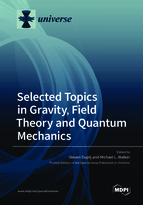Selected Topics in Gravity, Field Theory and Quantum Mechanics
A special issue of Universe (ISSN 2218-1997). This special issue belongs to the section "Mathematical Physics".
Deadline for manuscript submissions: closed (30 June 2022) | Viewed by 17791
Special Issue Editors
Interests: supersymmetry; quantum groups; C*-algebra; multigravity; supermanifold
Special Issue Information
Dear Colleagues,
Quantum field theory has achieved some extraordinary successes over the past sixty years, yet it retains a set of challenging problems. It is not yet able to describe gravity in a mathematically consistent manner. CP violation remains unexplained. Grand unified theories have been eliminated by experiment, and a viable unification model has yet to replace them. Even the highly successful quantum chromodynamics, despite significant computational achievements, struggles to provide theoretical insight into the low-energy regime of quark physics, where the nature and structure of hadrons are determined. The only proposal for resolving the fine-tuning problem, low-energy supersymmetry, has been eliminated by results from the LHC.
However, new ideas are available and approaching maturity. In quantum gravity, for example, naive treatment of metric perturbations such as the gravitational quanta has given way to recognizing the importance of vierbein, with insightful inroads into local quantization of the Poincare group. An approach to unifying gravity with the gauge theories has emerged which is based on braid groups. Covariant techniques for identifying dominant subgroups in gauge theory dynamics have gained recognition, and a generalization of Hamiltonian dynamics offers a fresh way to identify and treat the topological degrees of freedom.
Since mathematics is the true and proper language for quantitative physical models, we expect new mathematical constructions to provide insight into physical phenomena and fresh approaches for building physical theories.
Dr. Steven Duplij
Dr. Michael L. Walker
Guest Editors
Manuscript Submission Information
Manuscripts should be submitted online at www.mdpi.com by registering and logging in to this website. Once you are registered, click here to go to the submission form. Manuscripts can be submitted until the deadline. All submissions that pass pre-check are peer-reviewed. Accepted papers will be published continuously in the journal (as soon as accepted) and will be listed together on the special issue website. Research articles, review articles as well as short communications are invited. For planned papers, a title and short abstract (about 100 words) can be sent to the Editorial Office for announcement on this website.
Submitted manuscripts should not have been published previously, nor be under consideration for publication elsewhere (except conference proceedings papers). All manuscripts are thoroughly refereed through a single-blind peer-review process. A guide for authors and other relevant information for submission of manuscripts is available on the Instructions for Authors page. Universe is an international peer-reviewed open access monthly journal published by MDPI.
Please visit the Instructions for Authors page before submitting a manuscript. Submitted papers should be well formatted and use good English. Authors may use MDPI's English editing service prior to publication or during author revisions.
Keywords
- gravity
- Clairaut equation
- Cho-Duan-Ge decomposition
- constraintless formalism
- polyadic algebraic systems






